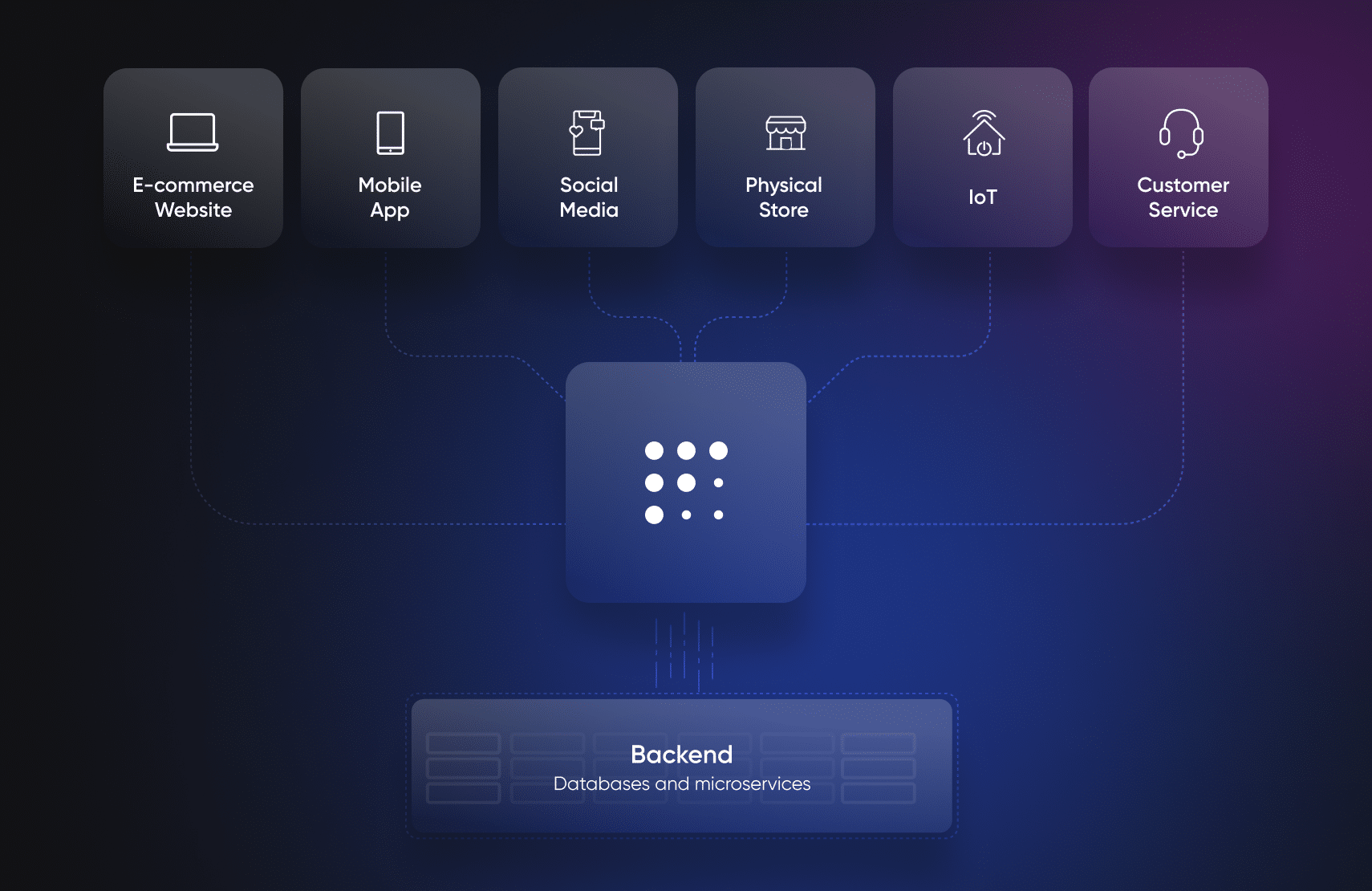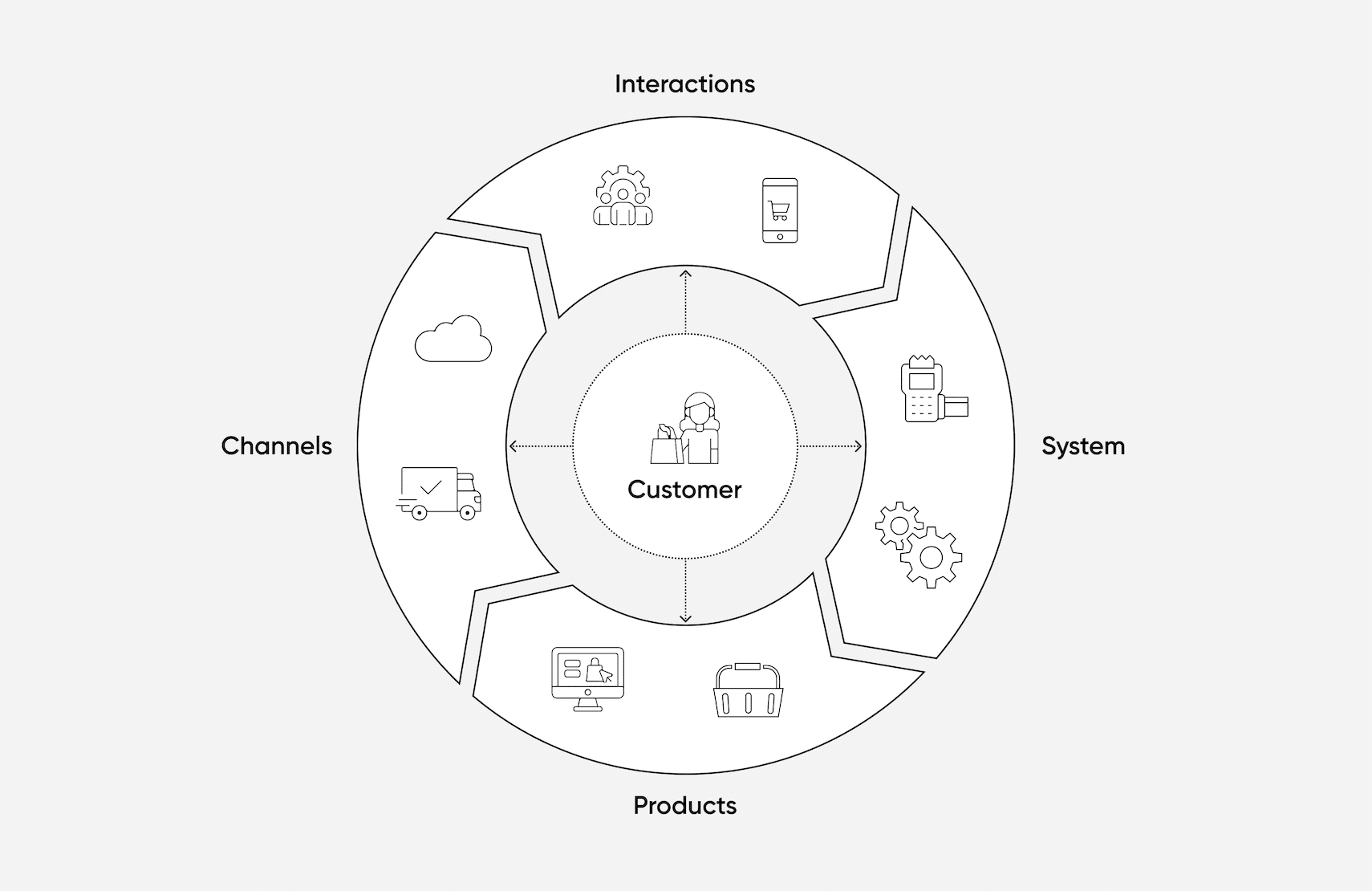How Omnichannel Commerce Works

Omnichannel commerce provides a seamless and consistent shopping experience by connecting all sales channels.
A true omnichannel experience enables customers to start their purchase journey at one touchpoint and complete the same purchase at other touchpoints.
A headless architecture allows you to push accurate and up-to-date product data to every sales channel.
A DXP allows you to create personalized experiences across multiple touchpoints without having to update multiple frontends.
[toc-embed headline=”Omnichannel Commerce Definition”]
Omnichannel Commerce Definition
Omnichannel commerce is a sales approach that allows retailers to provide a unified experience to customers across all channels (physical store, online store, social media, etc.).
[toc-embed headline=”Overview of Omnichannel Commerce”]
Overview of Omnichannel Commerce
Omnichannel commerce involves connecting every sales channel, so customers enjoy a unified shopping experience across any combination of touchpoints, including:
- E-commerce stores
- Digital marketplaces
- Mobile apps
- Social media
- IoT devices
- Physical storefronts
- Customer Service Systems
Businesses are quickly adopting an omnichannel approach to meet the shift in shopping behavior as customer journeys are more complex than they were in the past. Studies have shown that most customers don’t shop solely in-store or online. Instead, they shop through a variety of channels and conduct a more thorough process of finding the right product, including reading reviews, comparing prices, and seeking out personalized discounts.
This makes it important for retailers to not only sell products on multiple channels but to also ensure a connected experience across all touchpoints. Omnichannel commerce allows retailers to respond to customers’ needs with a central database of products and prices while creating unique frontend content for each channel. The result is a seamless experience that syncs all channels and provides customers with a greater level of convenience and personalization.
Unified experiences
The various channels in an omnichannel experience influence a customer’s shopping behavior. Each channel presents customers with the opportunity to complete a transaction such as placing an order or returning an item. Every transaction can be broken down into sub-steps such as viewing a product page, adding a product to a shopping cart, or saving an item to a wishlist.
A unified experience exists when a customer is able to complete a transaction after using different channels for each sub-step. For example:
- A customer adds a product to their shopping cart via a website on a desktop. Later, they access a mobile app to add two more products to the cart before returning to the desktop site later that day to complete the purchase.
- A customer adds an item to their cart via a smart home device and later completes the order via a mobile app.
- A customer begins the return process via the website and brings the product to a physical store to complete the process.
With omnichannel, you can use the data collected through multiple user touchpoints to customize offers and experiences to better align with each customer’s interests.
Multichannel vs omnichannel
Like omnichannel, multichannel commerce involves selling products through a variety of different sales channels. The difference between the two is that, with multichannel, retailers manage each channel separately whereas omnichannel provides centralized data management to connect all channels so that customers have a consistent experience at every touchpoint
[toc-embed headline=”How Omnichannel Commerce Works”]
How Omnichannel Commerce Works
Omnichannel commerce requires synchronization of all components of your e-commerce architecture, meaning there is a total integration of data allowing for a free flow of information between all channels.
To provide accurate and up-to-date product information for every channel, your backend needs a central hub for product data. Implementing a headless architecture enables you to use commerce services such as product information management (PIM) systems and order management systems (OMS) to handle this backend functionality.
A headless architecture uses commerce APIs to pull information to any channel, including websites, apps, smart appliances, social networks, and online marketplaces. When a customer makes a purchase, the API communicates between payment processing and other backend services to ensure all data is up to date. Because all frontends use the same API service layer, customers receive a unified user experience across all channels.
Creating frontend experiences
While it’s essential to have a central hub for all product data, an efficient way is also needed to craft frontend experiences relevant to each channel. With traditional content management systems (CMS), it can be challenging to build a viable omnichannel setup while creating quality content for more than one channel.
A digital experience platform (DXP) allows you to deliver personalized, content-rich experiences across multiple digital channels without having to update each frontend individually. With a DXP, you can connect the platform to emerging channels and touchpoints with ease, and it includes a headless CMS that you can use to create and publish content across these channels.
A DXP allows you to choose your preferred vendors for each of your applications by providing smooth and seamless integrations. Data is pulled using APIs and delivered to the central digital experience platform, allowing you to provide personalized content at scale. A DXP also provides the architecture and flexibility to make it easy to view everything in a single place.
[toc-embed headline=”Examples of Omnichannel Commerce”]
Examples of Omnichannel Commerce
Starbucks
Starbucks provides an excellent example of omnichannel commerce. Besides ordering in-person, you are able to place an order online or via a mobile app and pick up your order in-store, and all product information is accurately synced so you know exactly what is available at the store of your choice.
Their customer loyalty program seamlessly tracks purchases made through every channel. Customers are able to reload their rewards card via website, mobile app, in-store, or by phone, and all changes are updated across all channels in real-time.
GNC
Another great example of a company embracing omnichannel commerce is GNC.
GNC is a B2C omnichannel retailer in the health and wellness industry. Customers can use its mobile app, powered by fabric, to explore a more unified shopping experience. In addition to being able to shop online 24 hours a day, 7 days a week, customers can also purchase products from anywhere their phone has an internet connection.
Customers also use search, browse, and other related activities to discover the product details online and then go into a store to complete the purchase transaction, which includes redeeming their loyalty points and subscribing to health and wellness products such as vitamins and healthy meals.
[toc-embed headline=”Omnichannel Vs Unified Commerce”]
Omnichannel Vs Unified Commerce

Unified commerce is an experience-led approach that brings together the transactional functionality of a retail platform with customer data insights.
A unified approach is the next step in omnichannel retail, ensuring that you can combine inventory, customer, and order data to create seamless personalized experiences that increase sales. Research from consulting firm McKinsey shows that 83% of online customers want their shopping experience to be personalized, and effective personalization can increase store revenues by 20-30%.
Unified commerce combines sales and data functions seamlessly in a single platform so that retailers can deliver personalized, omnichannel experiences to their shoppers.
Unified commerce is an experience-led approach that brings together the transactional functionality of a retail platform with customer data insights. Retailers today collect data from numerous sources, from websites to mobile apps, loyalty programs, and point-of-sale (POS) terminals. Having a single view of that data allows you to analyze and forecast customer behavior, using that information to enhance the user experience across retail channels.
E-commerce is becoming increasingly diversified across channels, including online stores, marketplaces, and brick-and-mortar stores. That can result in a fragmented user experience in which storefronts carry outdated information about product inventory levels and incomplete customer records.

Program management @ fabric. Previously strategic transformation @ Lululemon, Amazon, Target, and JCPenney.